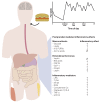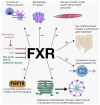Human Postprandial Nutrient Metabolism and Low-Grade Inflammation: A Narrative Review
- PMID: 31817857
- PMCID: PMC6950246
- DOI: 10.3390/nu11123000
Human Postprandial Nutrient Metabolism and Low-Grade Inflammation: A Narrative Review
Abstract
The importance of the postprandial state has been acknowledged, since hyperglycemia and hyperlipidemia are linked with several chronic systemic low-grade inflammation conditions. Humans spend more than 16 h per day in the postprandial state and the postprandial state is acknowledged as a complex interplay between nutrients, hormones and diet-derived metabolites. The purpose of this review is to provide insight into the physiology of the postprandial inflammatory response, the role of different nutrients, the pro-inflammatory effects of metabolic endotoxemia and the anti-inflammatory effects of bile acids. Moreover, we discuss nutritional strategies that may be linked to the described pathways to modulate the inflammatory component of the postprandial response.
Keywords: bile acids; low-grade inflammation; microbiome; nutrients; postprandial inflammation.
Conflict of interest statement
M.V.W. is owner of Nature Plus. M.N. is co-founder and in the Scientific Advisory board of Caelus Health and Kaleido Biosciences. None of these conflicts of interest bear direct relevance to this manuscript. The other authors declare no conflict of interest.
Figures


References
-
- Bozzetto L., Annuzzi G., Ragucci M., Di Donato O., Della Pepa G., Della Corte G., Griffo E., Anniballi G., Giacco A., Mancini M., et al. Insulin resistance, postprandial GLP-1 and adaptive immunity are the main predictors of NAFLD in a homogeneous population at high cardiovascular risk. Nutr. Metab. Cardiovasc. Dis. 2016;26:623–629. doi: 10.1016/j.numecd.2016.01.011. - DOI - PubMed
-
- Tang M.W., Koopman F.A., Visscher J.P.M., de Hair M.J., Gerlag D.M., Tak P.P. Hormone, metabolic peptide, and nutrient levels in the earliest phases of rheumatoid arthritis—contribution of free fatty acids to an increased cardiovascular risk during very early disease. Clin. Rheumatol. 2017;36:269–278. doi: 10.1007/s10067-016-3456-x. - DOI - PMC - PubMed
-
- Ruiz-Núñez B., Pruimboom L., Dijck-Brouwer D.A.J., Muskiet F.A.J. Lifestyle and nutritional imbalances associated with Western diseases: Causes and consequences of chronic systemic low-grade inflammation in an evolutionary context. J. Nutr. Biochem. 2013;24:1183–1201. doi: 10.1016/j.jnutbio.2013.02.009. - DOI - PubMed
Publication types
MeSH terms
Substances
Grants and funding
LinkOut - more resources
Full Text Sources
Other Literature Sources

